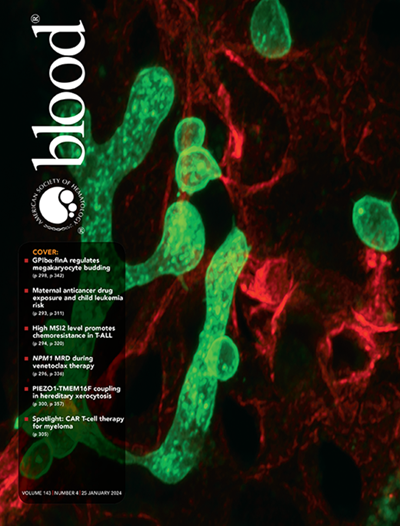靶向STK17B激酶激活铁下垂并抑制多发性骨髓瘤的耐药。
IF 23.1
1区 医学
Q1 HEMATOLOGY
引用次数: 0
摘要
多发性骨髓瘤(MM)是一种无法治愈的浆细胞恶性肿瘤,其进展通常与铁凋亡的抑制有关,铁凋亡是一种由铁依赖性脂质过氧化引起的细胞死亡。这种抑制背后的机制在很大程度上仍然未知。在这里,我们发现STK17B激酶是MM中铁凋亡的关键抑制因子。STK17B水平升高与MM患者的总生存率低相关,并且STK17B在复发的MM病例中的表达明显高于新诊断的MM病例。我们发现,抑制MM细胞中的STK17B增加了不稳定铁池,增强了脂质过氧化,并使细胞对常规抗MM治疗敏感。值得注意的是,一种口服的、内部生成的STK17B抑制剂可诱导铁下垂,并显著降低MM异种移植小鼠模型中的肿瘤生长。在机制上,邻近标记法结合磷酸化蛋白质组学分析确定了STK17B的两个主要铁摄取和运输调节因子:铁响应元件结合蛋白2 (IREB2)和热休克蛋白家族B成员1 (HSPB1)。我们发现STK17B磷酸化了IREB2 (S157)和HSPB1 (S15)上的关键调控位点,从而调节了IREB2和HSPB1下游效应蛋白、亲铁铁蛋白受体和抗铁铁蛋白重链蛋白之间的平衡。此外,我们证明STK17B间接维持STAT3的激活磷酸化,STAT3是铁凋亡抑制因子和MM病理生物学的主要驱动因素。我们的研究结果发现了一个具有临床相关性和可靶向性的STK17B-pIREB2S157/pHSPB1S15信号轴,该信号轴抑制铁下沉并有助于MM的耐药。本文章由计算机程序翻译,如有差异,请以英文原文为准。
Targeting STK17B kinase activates ferroptosis and suppresses drug resistance in multiple myeloma.
The progression of multiple myeloma (MM), an incurable malignancy of plasma cells, is often associated with the suppression of ferroptosis, a type of cell death driven by iron-dependent lipid peroxidation. The mechanisms underlying this suppression remain largely unknown. Here, we identified STK17B kinase as a critical suppressor of ferroptosis in MM. Elevated levels of STK17B are associated with poor overall survival in MM patients and STK17B expression is significantly higher in relapsed vs newly diagnosed MM cases. We found that inhibiting STK17B in MM cells increased the labile iron pool, enhanced lipid peroxidation, and sensitized cells to conventional anti-MM therapies. Notably, an orally available, in-house-generated STK17B inhibitor induced ferroptosis and significantly reduced tumor growth in MM xenograft mouse models. Mechanistically, proximity labeling assay combined with the phospho-proteomic analysis identified two major regulators of iron uptake and transport as direct targets of STK17B: iron-responsive element binding protein 2 (IREB2) and heat shock protein family B member 1 (HSPB1). We demonstrated that STK17B phosphorylates critical regulatory sites on IREB2 (S157) and HSPB1 (S15), thereby modulating the balance between IREB2 and HSPB1 downstream effectors, pro-ferropototic transferrin receptor and anti-ferroptotic ferritin heavy chain proteins. Furthermore, we demonstrated that STK17B indirectly maintains activating phosphorylation of STAT3, a ferroptosis suppressor and a major driver of MM pathobiology. Our findings uncovered a clinically relevant and targetable STK17B-pIREB2S157/pHSPB1S15 signaling axis that suppresses ferroptosis and contributes to drug resistance in MM.
求助全文
通过发布文献求助,成功后即可免费获取论文全文。
去求助
来源期刊

Blood
医学-血液学
CiteScore
23.60
自引率
3.90%
发文量
955
审稿时长
1 months
期刊介绍:
Blood, the official journal of the American Society of Hematology, published online and in print, provides an international forum for the publication of original articles describing basic laboratory, translational, and clinical investigations in hematology. Primary research articles will be published under the following scientific categories: Clinical Trials and Observations; Gene Therapy; Hematopoiesis and Stem Cells; Immunobiology and Immunotherapy scope; Myeloid Neoplasia; Lymphoid Neoplasia; Phagocytes, Granulocytes and Myelopoiesis; Platelets and Thrombopoiesis; Red Cells, Iron and Erythropoiesis; Thrombosis and Hemostasis; Transfusion Medicine; Transplantation; and Vascular Biology. Papers can be listed under more than one category as appropriate.
 求助内容:
求助内容: 应助结果提醒方式:
应助结果提醒方式:


